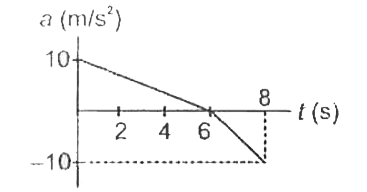The velocity in m/s of a particle is proportional to the cube of the time. If the velocity after 2 s is 4m/s, then v is equal to
t3
t32
t33
t34
To solve the problem, we need to establish the relationship between velocity and time based on the information given.
1. Understanding the Relationship:
The problem states that the velocity v of a particle is proportional to the cube of the time t. This can be expressed mathematically as:
v=k⋅t3
where k is the constant of proportionality.
2. Using the Given Information:
We know that the velocity after 2 seconds is 4 m/s. We can substitute t=2 and v=4 into the equation:
4=k⋅(23)
3. Calculating k:
Simplifying the equation:
4=k⋅8
To find k, divide both sides by 8:
k=48=12
4. Finding the Velocity v:
Now that we have k, we can express the velocity in terms of time:
v=12⋅t3
To find v for any time t, we can substitute the value of t into this equation.
5. Example Calculation:
If we want to find the velocity at a different time, say t=1 second, we substitute:
v=12⋅(13)=12⋅1=12 m/s
If we want to find the velocity at t=3 seconds:
v=12⋅(33)=12⋅27=272 m/s=13.5 m/s
Final Answer:
Thus, the expression for the velocity v in terms of time t is:
v=12t3
The problem states that the velocity v of a particle is proportional to the cube of the time t. This can be expressed mathematically as:
v=k⋅t3
where k is the constant of proportionality.
We know that the velocity after 2 seconds is 4 m/s. We can substitute t=2 and v=4 into the equation:
4=k⋅(23)
Simplifying the equation:
4=k⋅8
To find k, divide both sides by 8:
k=48=12
Now that we have k, we can express the velocity in terms of time:
v=12⋅t3
To find v for any time t, we can substitute the value of t into this equation.
If we want to find the velocity at a different time, say t=1 second, we substitute:
v=12⋅(13)=12⋅1=12 m/s
If we want to find the velocity at t=3 seconds:
v=12⋅(33)=12⋅27=272 m/s=13.5 m/s
Thus, the expression for the velocity v in terms of time t is:
v=12t3
Topper's Solved these Questions
Similar Questions
Two particles A and B separated by 10 m at time t=0 are moving uniformly. A is moving along line AB at a constant velocity of 4m/s and B is moving perpendicular to the velocity of A at a constant velocity of 5m/s. After what time the two particles will be nearest to each other?

View SolutionA particle is moving with velocity v=t3−6t2+4, where v is in m/s and t is in seconds. At what time will the velocity be maximum//minimum and what is it equal to?
View Solution
Knowledge Check
If the distance s covered by a particle in time t is proportional to the cube root of its velocity, then the acceleration is
Aa constantB∝s3C∝1s3D∝s5The velocity of a particle at an instant is 10 m/s. After 5 s, the velocity of the particle is 20 m/s. The velocity at 3 s before the instant when the velocity of the particle was 10 m/s is
A8 m/sB6 m/sC4 m/sD7 m/sThe velocity of a particle at an instant is 10m/s. After 5sec, the velocity of the particle is 20m/s. Find the velocity at 3 seconds before from the instant when velocity of a particle is 10m/s.
A8m/sB4m/sC6m/sD7m/s
The acceleration of a particle is given by, a = t/6 at t = 0, velocity v = 2 m/s, displacement s= 2m. Find the velocity at t= 4 seconds,
View SolutionIf velocity of a particle is given by v=(2t+3)m/s. Then average velocity in interval 0≤t≤1 s is :
View SolutionA ball is thrown vertically downward with a velocity of 20m/s from the top of a tower,It hits the ground after some time with a velocity of 80m/s .The height of the tower is : (g=10mg2)
View SolutionThe maximum velocity of a particle performing a S.H.M is v. If the periodic time is made 1/3rd and the amplitude is doubled, then the new maximum velocity of the particle will be
View SolutionThe acceleration - time graph for a particle moving along x - axis is shown in figure, If the initial velocity of particle is −5m/s, the velocity at t = 8 s is

View Solution
